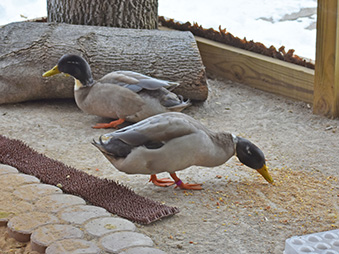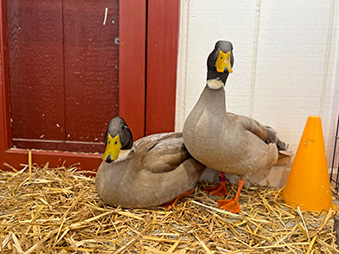Anas platyrhynchos domestic | Mallard duck
Names:
- Male: Claude, Peach, Pickles, Puddles, Wolfgang
- Female: Suka



Meet the Flock
Our resident ducks might trace their roots back to the wild Mallard (Anas platyrhynchos), but they’ve each got their own charm and quirks! While many of our ducks resemble classic domestic Mallards, a few special members of the flock stand out. Meet Wolfgang, Claude, and Johann—likely the result of a domestic and wild duck cross from the nearby pond. These “whoopsie” babies may not have an official breed, but they’re full of personality and just as cherished by our team.
Mallards: From Wetlands to Barnyards
The wild Mallard is one of the most widespread and successful duck species in the world. Known for their vibrant colors and strong flying abilities, wild Mallards migrate across thousands of miles between seasons.
Domestic Mallards, like our flock, are bred for traits like size, temperament, and egg-laying ability. As a result, they've lost much of their wild ancestors' flight strength and agility. So, while wild Mallards soar across the skies, our ducks are content to waddle around their cozy zoo habitat.
Why Ducks Were Domesticated
Ducks were first domesticated more than 4,000 years ago in regions like Egypt, China, and Europe, primarily for their meat, eggs, and soft down feathers. In fact, ducks often outperform chickens in egg production! While commercial chickens (like White Leghorns) produce about 250–280 eggs per year, domestic ducks can lay up to 300–350 eggs annually. Their eggs are not only bigger, averaging 32–34 oz per dozen compared to 24–26 oz for chickens, but are also richer in Omega-3 fatty acids.
As ducks became more integrated into human life, both their bodies and behaviors changed. Today’s domestic ducks are heavier, more relaxed, and more people-friendly than their wild counterparts.
Feathers, Feet, and Floatation: Duck Adaptations
Ducks are perfectly built for life on the water. Their webbed feet act like paddles, while legs set far back on their bodies help them swim efficiently, though it gives them their signature waddle on land.
To stay buoyant, ducks use a special oil gland near the base of their tail, called a uropygial or preen gland. During preening, they spread this oil over their feathers to waterproof them and stay afloat. Their broad, flat bills are ideal for dabbling—scooping up a diverse diet of insects, crustaceans, small amphibians, fish, seeds, and aquatic plants. Because ducks consume both plants and other animals, they are considered omnivorous.
Who's Who in the Sky?
Wondering how to identify a duck in flight? Look for a compact body, a long-outstretched neck, rapid wingbeats, and an arched flight path. Wild Mallards are agile flyers and often travel in V-formations to conserve energy. While our domestic ducks aren’t likely to take off, wild Mallards occasionally pass over the zoo—a fun opportunity to practice your ID skills!
Moms Do the Work: Sexual Dimorphism in Ducks
In the duck world, it’s the females who do the heavy lifting when it comes to raising young. Female Mallards build the nests, incubate the eggs, and care for the ducklings on their own. Nests are usually well-hidden on the ground or in tree hollows and are made from surrounding plant materials and soft down feathers. Most domestic ducks, on the other hand, rely on their humans to provide shelter and nesting materials.
Mallards are also a great example of sexual dimorphism, when males and females of the same species look and behave differently. Males (drakes) sport glossy green heads, bright yellow bills, and striking white neck rings, while females (hens) are mottled brown for camouflage. Both sexes, however, share a beautiful iridescent blue patch on their wings called the speculum, bordered by white stripes.
Ducks in the Ecosystem
Wild ducks play an important role in maintaining healthy wetlands. As they forage, they stir up sediments and cycle nutrients. Their droppings fertilize aquatic plants, and they serve as both predators and prey within the food web. Ducks also help disperse seeds and tiny invertebrates between ponds and lakes, contributing to ecosystem diversity and connectivity.
Avian Influenza: Safety Behind the Scenes
Due to the continued presence of avian influenza (bird flu) in wild bird populations, our ducks are currently housed behind the scenes for their safety. Waterfowl, especially ducks, can carry and spread the virus even without showing symptoms. To protect them—and other birds in the zoo—we’ve increased our biosecurity measures.
You may notice additional footbaths, signage, or restricted areas in certain locations around the zoo. These precautions are all part of our commitment to animal welfare and public safety.
Learn more about avian influenza and how you can help: CDC Avian Influenza Info
Fact Sheet
Taxonomy
Genus: Anas | Species: platyrhynchos | Subspecies: domesticus |
Kingdom: Animalia | Phylum: Chordata | Class: Aves | Order: Anseriformes | Family: Anatidae |
Favorite Enrichment Type
Mud puddles to dabble in!
Life Span
- In the Wild: Domestic
- In Human Care: Up to 20+ years
Diet
- In the Wild: Domestic
- At the Zoo: Waterfowl chow, greens, and insects
Geographic Range
Domestic
Habitat
Areas near calm water.
Fun Facts About Ducks!
- Dabblers vs. Divers: Our ducks are dabblers, feeding at or near the surface of the water. Other ducks, like mergansers, dive deep for fish!
- Flightless Friends: Domestic ducks often can’t fly due to their heavier bodies and reduced flight muscles.
- Feather Count: Ducks have over 10,000 feathers! That’s more than most non-water birds, helping with insulation and waterproofing.
- Color Chameleons: Male Mallards molt after the breeding season, temporarily looking more like females to avoid predators.
- Bill Filters: Dabbling ducks have something called lamellae-comb like protrusions along the inside of the bill. They help strain food from water, kind of like a built-in sieve.
- Built-in Water Goggles: Ducks have a third eyelid (called a nictitating membrane) that protects their eyes and helps them see underwater.
Status: Not Evaluated (Domesticated)
International Union for Conservation of Nature (IUCN) – Not Evaluated.
How to Find Us
Is someone missing? Due to the pervasiveness of Avian Influenza, our domestic ducks are behind the scenes and not visible to the public. We hope that these fun feathered friends will be able to join us again soon, once it is safe to do so. If you would like to learn more about how you can keep your birds safe at home from Avian Influenza, check out your local health organization.
